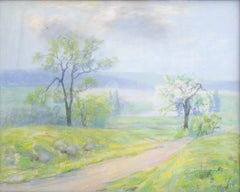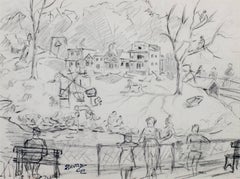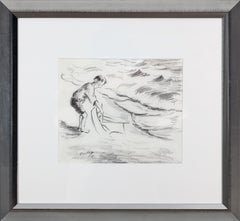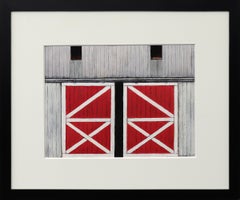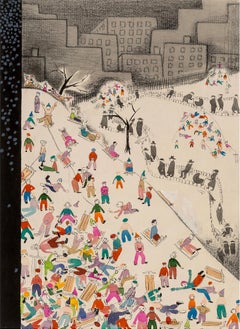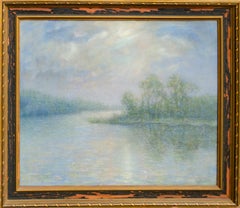Francesco Spicuzza Landscape Drawings and Watercolors
Italian, American, 1883-1962
Italian-born Francesco Spicuzza was primarily a Wisconsin painter who did portraits, still-lives and local landscapes. He spent the first part of his life in near-poverty to become a painter. An eternal optimist, in 1917, the artist reported: "I am happy and my only ambition now is to paint better and better until I shall have reached the measure of the best of which I am capable." (Spicuzza, 1917, p. 22). His predilection for beach scenes germinated early: reportedly, the five-year-old boy first drew the outlines of his father's fishing boat in the sand on the seashore near their home in Sicily. After setting himself up as a fruit peddler in Milwaukee, Spicuzza's father sent for his family when Francesco was eight years old.
In 1899 or 1900, Spicuzza began studying drawing and anatomy under Robert Schade (1861-1912), a painter of panoramas who had been trained in Munich under Carl Theodor von Piloty. Spicuzza was also taught by Alexander Mueller (1872-1935), a product of the Weimar and Munich academies.
The earliest influences in his work appear to be from Edward H. Potthast and Maurice Prendergast, though Spicuzza never mentioned either artist. Already in August 1910, Spicuzza was described in a newspaper as "one of the most talented of Milwaukee's rising workers." He undoubtedly received lasting inspiration from his one summer study period in 1911 with John F. Carlson at the Art Students League's Summer School in Woodstock, New York. Although he executed numerous still-lives and an occasional religious work, Spicuzza is best known for his Milwaukee beach scenes populated with frolicking bathers in multi-colored attire, not unlike the images of Potthast, who used a similar technique. These beach genre scenes reflect the attitude of American impressionists who depicted the more pleasant side of life.
Spicuzza manipulated a successful balance of rich pigment applied in varying degrees of impasto texture with subtle nuances of hue. Working all'aperto, he sought "the soft enticing shades of yellow, blue, green, pink and lavender . . . to get the effects of bright glistening summer air." (L.E.S., n.d.). As a painter whose color not only derived from direct observation but also from a personal theory of color symbolism, Spicuzza traded the linear approach of lithography for dynamic patches of brilliant color. Like Prendergast, he would often tilt the angle of the picture plane to bring the viewer's position above the scene.
Spicuzza spent a great deal of time painting en plein air and by 1925 he began summering at Big Cedar Lake, near West Bend, Wisconsin to gather his subject matter. During the difficult era of the Depression, patrons came to Spicuzza's aid and during the 40s, he taught housewives, businessmen and students at the Milwaukee Art Institute, the Milwaukee Art Center, and in his studio. In the following decade, although his kind of art was no longer popular in the "make-it-or-break-it" New York gallery world, Spicuzza enjoyed regular patronage and sales.
Bio by Richard H. Love and Michael Preston Worley, Ph.D.to
1
1
1
Overall Width
to
Overall Height
to
3
1
1
2
1
2
2
1
1
1
1
1
1
1
2
2
2
2
1
16
143
123
66
60
2
1
3
Artist: Francesco Spicuzza
Beautiful large impressionist pastel by Francesco Spicuzza
By Francesco Spicuzza
Located in New York, NY
Francesco Spicuzza (American, 1883-1962)
Untitled Landscape, 20th century
Pastel on paper
Sight size: 24 x 30 in.
Framed: 26 1/4 x 32 3/8 in.
Signed lower right: Spicuzza
Italian-born Francesco Spicuzza was primarily a Wisconsin painter who did portraits, still-lives and local landscapes. He spent the first part of his life in near-poverty to become a painter. An eternal optimist, in 1917, the artist reported: "I am happy and my only ambition now is to paint better and better until I shall have reached the measure of the best of which I am capable." (Spicuzza, 1917, p. 22). His predilection for beach scenes germinated early: reportedly, the five-year-old boy first drew the outlines of his father's fishing boat in the sand on the seashore near their home in Sicily. After setting himself up as a fruit peddler in Milwaukee, Spicuzza's father sent for his family when Francesco was eight years old. For the following six years the boy was unable to attend school because of his job in his father's fruit and vegetable business. The poor lad suffered a caved-in shoulder from carrying a heavy wooden crate.
The young Spicuzza was aided by moral and financial support from a sympathetic Milwaukee businessman named John Cramer, publisher and editor of the Evening Wisconsin, who raised Spicuzza's salary as a newspaper assembler so that he could attend school. In 1899 or 1900, Spicuzza began studying drawing and anatomy under Robert Schade (1861-1912), a painter of panoramas who had been trained in Munich under Carl Theodor von Piloty. Spicuzza was also taught by Alexander Mueller (1872-1935), a product of the Weimar and Munich academies. Mueller realized Spicuzza was a colorist and encouraged that orientation (Madle, 1961). Spicuzza found it beneficial to accept an apprenticeship in a lithographic studio for $8 a week, which demanded most of his time. During the St. Louis Universal Exposition in 1904, still a struggling student, Spicuzza attended the fair, thanks to Cramer. It was not long before Spicuzza received a twenty-five dollar portrait commission, and this inaugural success led to new commissions and allowed him to continue as a painter.
The earliest influences in his work appear to be from Edward H. Potthast and Maurice Prendergast, though Spicuzza never mentioned either artist. Already in August 1910, Spicuzza was described in a newspaper as "one of the most talented of Milwaukee's rising workers." He undoubtedly received lasting inspiration from his one summer study period in 1911 with John F. Carlson at the Art Students League's Summer School in Woodstock, New York. Certainly Spicuzza would have picked up spontaneity in handling the brush from Carlson. Although he executed numerous still-lives and an occasional religious work, Spicuzza is best known for his Milwaukee beach scenes populated with frolicking bathers in multi-colored attire, not unlike the images of Potthast, who used a similar technique. Many of these are small, preparatory works on canvas board executed between 1910 and 1915. Frequently with even greater animation than Potthast, Spicuzza produced moving images of youthful energy and uninhibited child's play. These beach genre scenes reflect the attitude of American impressionists who depicted the more pleasant side of life.
Spicuzza manipulated a successful balance of rich pigment applied in varying degrees of impasto texture with subtle nuances of hue. Working all'aperto, he sought "the soft enticing shades of yellow, blue, green, pink and lavender . . . to get the effects of bright glistening summer air." (L.E.S., n.d.). As a painter whose color not only derived from direct observation but also from a personal theory of color symbolism, Spicuzza traded the linear approach of lithography for dynamic patches of brilliant color. Like Prendergast, he would often tilt the angle of the picture plane to bring the viewer's position above the scene.
Spicuzza was unable to enter the 1913 Armory Show or the Panama-Pacific International Exposition two years later but he did submit work to the annual exhibitions of the Pennsylvania Academy of the Fine Arts and those of the Art Institute of Chicago. His first important award was the bronze medal presented by the St. Paul Institute in 1913, which was followed by the silver medal two years later. Before long, Spicuzza had acquired a greater sense of security in his profession and was described by a writer in International Studio (April 1917) as "an independent artist with an assured future. His pastels and water-colours are poetic and joyous bits of nature with a genuine out-of-door feeling." In 1918, his Spirit of Youth, exhibited at the National Academy of Design, sold for $112.50. Four years later, the artist achieved his greatest local recognition by winning the gold medal from the Milwaukee Art Institute.
Spicuzza spent a great deal of time painting en plein air and by 1925 he began summering at Big Cedar Lake, near West Bend, Wisconsin to gather his subject matter. Easter Morning (1926) owes something to the Symbolist movement, with its figure of Christ appearing over a seascape. During the difficult era of the Depression, patrons came to Spicuzza's aid and during the 40s, he taught housewives, businessmen and students at the Milwaukee Art Institute, the Milwaukee Art Center, and in his private studio. In the following decade, although his kind of art was no longer popular in the "make-it-or-break-it" New York gallery world, Spicuzza enjoyed regular patronage and sales. His beach scenes became more static and he would experiment with modernist techniques. Spicuzza died at the age of seventy-eight.
Sources:
L.E.S., "Do Colors Change a Person's disposition? Experiments of a Milwaukee Artist...
Category
20th Century American Modern Francesco Spicuzza Landscape Drawings and Watercolors
Materials
Paper, Pastel
Mid 20th century black and white drawing landscape trees houses figures signed
By Francesco Spicuzza
Located in Milwaukee, WI
"Monkey Island at Washington Park Zoo" is an original graphite and charcoal drawing on paper by Francesco Spicuzza. It depicts a number of figures gazing out at a monkey enclosure at a zoo. The artist signed the piece in the lower left.
8 1/2" x 11 3/4" art
17 1/4" x 21 1/8" frame
Francesco J. Spicuzza, born in Sicily on July 23, 1883, came to America at the age of 8. He supported himself as a fruit peddler until a newspaperman gave him $4 a week to go to school. He attended classes at the Milwaukee Art Students League, where he studied under Alexander Mueller. There he learned to paint in the then-fashionable "Munich School" technique, with detailed realism in heavy browns and grayed-out hues. Spicuzza completed eight grades in four years, and then in 1911, three businessmen advanced him enough money to allow him to study in New York under artist and teacher John Carlson. It was during this time that Spicuzza changed his style of painting, developing an impressionistic use of color, form and atmospheric renditions. After a period of grinding poverty, one of Spicuzza's pictures won a major New York competition. It was the first of 60 wins, both in the U.S. and Paris. He became a fashionable painter, and many of the leading collections have his work. Spicuzza's typical works were beach scenes, still life, landscapes and portraits done in pastels, oils, ink, charcoal and watercolors. Much of his work traced the history of Milwaukee in the early 1900s. He was probably best known for his scenes of women and children splashing in...
Category
1950s Francesco Spicuzza Landscape Drawings and Watercolors
Materials
Paper, Charcoal, Graphite
Boy Launching a Sailboat
By Francesco Spicuzza
Located in Milwaukee, WI
Graphite and charcoal on paper signed by the artist.
7.38" x 8.63"
16.75" x 15.5" frame
Framed to conservation standards. Float mounted on 100% cotton matboard and glazed in UF5 Plexiglass that filters 99% of UV Rays to ensure the preservation of the piece. All housed in a bold miter jointed bevel frame in distressed silver finish with reflective accents.
Francesco J. Spicuzza, born in Sicily on July 23, 1883, came to America at the age of 8. He supported himself as a fruit peddler until a newspaperman gave him $4 a week to go to school. He attended classes at the Milwaukee Art Students League, where he studied under Alexander Mueller. There he learned to paint in the then-fashionable "Munich School" technique, with detailed realism in heavy browns and grayed-out hues. Spicuzza completed eight grades in four years, and then in 1911, three businessmen advanced him enough money to allow him to study in New York under artist and teacher John Carlson.
It was during this time that Spicuzza changed his style of painting, developing an impressionistic use of color, form and atmospheric renditions. After a period of grinding poverty, one of Spicuzza's pictures won a major New York competition. It was the first of 60 wins, both in the U.S. and Paris. He became a fashionable painter, and many of the leading collections have his work. Spicuzza's typical works were beach scenes, still life, landscapes and portraits done in pastels, oils, ink, charcoal and watercolors. Much of his work traced the history of Milwaukee in the early 1900s. He was probably best known for his scenes of women and children splashing in the waves...
Category
Mid-20th Century Francesco Spicuzza Landscape Drawings and Watercolors
Materials
Charcoal, Graphite
Related Items
George Vander Sluis Oil Stick Landscape – Barn with Red Sliding Doors, 20th C.
Located in Denver, CO
This striking original work on paper, Barn Side with Sliding Doors, is a masterful example of mid-20th century American modernist landscape art by acclaimed artist and educator George Vander Sluis...
Category
1980s American Modern Francesco Spicuzza Landscape Drawings and Watercolors
Materials
Oil Pastel, Paper
$1,570
H 23 in W 27 in D 0.75 in
Children Snow Sledding in Central Park - New Yorker Cover Study
Located in Miami, FL
Hungarian/American artist/illustrator depicts a charming scene of sledding in the snow in Central Park. The work is abstract in its design as it's functional in its narrative - Unpublished New Yorker...
Category
1940s Modern Francesco Spicuzza Landscape Drawings and Watercolors
Materials
Charcoal, Ink, Watercolor, Gouache, Pencil
$15,000
H 16.85 in W 12.25 in
Portrait of artist Ida Bagoes Ketut Diding, Bali, 1937
Located in Amsterdam, NL
Ida Bagoes Ketut Diding, Artist on bali 1937
Signed with initials, dated and titled, bottom centre
Black chalk on paper, 29 x 31 cm
Literature:
Ernst Braches en J.F. Heijbroek, W....
Category
1930s Art Nouveau Francesco Spicuzza Landscape Drawings and Watercolors
Materials
Paper, Graphite
$23,104
H 11.42 in W 12.21 in D 1.19 in
"Central Park" Leon Dolice, New York Central Park Scene, Mid-Century
By Leon Dolice
Located in New York, NY
Leon Dolice
Central Park
Signed lower left
Watercolor on paper
12 x 19 inches
The romantic backdrop of Vienna at the turn of the century had a life-long influence upon the young ma...
Category
1930s American Modern Francesco Spicuzza Landscape Drawings and Watercolors
Materials
Paper, Pastel
"Empire State Building" Leon Dolice, New York City Street Scene, Mid-Century
By Leon Dolice
Located in New York, NY
Leon Dolice
Empire State Building
Signed lower right
Watercolor on paper
19 x 12 inches
The romantic backdrop of Vienna at the turn of the century had a life-long influence upon th...
Category
1930s American Modern Francesco Spicuzza Landscape Drawings and Watercolors
Materials
Paper, Pastel
"Hydrangeas, " Walter Inglis Anderson, Mississippi Southern Illustrator, Flowers
Located in New York, NY
Walter Anderson ( American, 1903 - 1965)
Hydrangeas, circa 1950
Mixed media on paper
11 x 8 1/2 inches
Provenance:
Luise Ross Gallery, New York
Private Collection, New Jersey
Acquired from the estate of the above, 2021
Walter Anderson firmly believed that quality art was an important part of life and should be made available to everyone. As he said, "There should be simple, good decorations, to be sold at prices to rival the five-and-ten." Noticing that only poor quality art was available in stores and little was available for children, he resolved to make art which could be reproduced easily and sell inexpensively — linoleum block prints. This technique enabled him to provide affordable, quality art.
The technique of linoleum block printing is a simple concept; however, it requires much skill and talent to actually produce memorable art. Anderson purchased surplus "battleship linoleum," thicker than ordinary linoleum with a burlap backing for better support, to create his blocks. During the mid-1940s, he created almost 300 linocuts working in the attic of the sea-side plantation house, Oldfields, his wife's family home in Gautier. Masses of linoleum chips accumulated at the foot of the attic stairs as he often worked night and day. He began with sketching out a design directly on the linoleum. Once he had carved the image into the surface, he used the back of faded, surplus stock wallpaper that a friend sent him, laying long strips on top of the inked linoleum. A roller made of sewer pipe filled with sand served as his press. When the print was completed, he often colored it by hand with bold strokes and vivid colors. The prints were sold at Shearwater Pottery, the family business, for a mere dollar a foot.
But "what about a well-designed fairy tale for a child's room?" he asked himself. Since there was a lack of affordable art for children, much of his work with linoleum blocks focused on subjects for children. He depicted fables and fairy tales ranging from Arabian Nights, to Germany and the Grimm Brothers' Rapunzel, to the French story of The White Cat, to the Greek tales such as Europa and the Bull, and to tales from China, India, and other cultures. Anderson also created "mini" books featuring the alphabet and Robinson Cat. The blocks are not only alive with the story being depicted, but they are also filled with designs taken from Best-Maugard's Method for Creative Design. Swirls, half-circles and zig-zag lines fill every available space on the linoleum block making them come alive and capture their audience.
But fairy tales, children's verses and the "mini" books, consisting of about 90 blocks, were not the sole subject of Anderson's linoleum block prints. In total, he created approximately 300 linoleum blocks with subjects ranging from coastal flora and fauna, coastal animals, and sports and other coastal activities. Anderson even created linoleum blocks to be used to print tablecloths and clothing, some worn by his own children. Color and subjects of the linoleum block prints were not the only things that got them noticed.
In 1945 when Anderson was creating these prints, the standard size of linoleum block prints was only 12 by 18 inches. These small dimensions were due to the common size of the paper available and the restrictions made by national competitions. Since Anderson used wallpaper...
Category
Mid-20th Century American Modern Francesco Spicuzza Landscape Drawings and Watercolors
Materials
Paper, Crayon
Grace Martin Taylor (Frame), (Town View), 1930, pastel, signed
Located in New York, NY
West Virginia native Grace Martin Taylor, artist for the brightly colored pastel (TownView), attended the Pennsylvania Academy of Fine Arts and the Art S...
Category
1930s American Modern Francesco Spicuzza Landscape Drawings and Watercolors
Materials
Pastel
"Chrysler Building" Leon Dolice, New York City Street Scene, Mid-Century
By Leon Dolice
Located in New York, NY
Leon Dolice
Chrysler Building
Signed lower right
Watercolor on paper
19 x 12 inches
The romantic backdrop of Vienna at the turn of the century had a life-long influence upon the yo...
Category
1930s American Modern Francesco Spicuzza Landscape Drawings and Watercolors
Materials
Pastel, Paper
City - Mixed Media by N. Czinober - mid 20th Century
By Nicolas Czinober
Located in Roma, IT
City is an original drawing in pencil made by the Hungarian artist Nicolas Czinober in the mid-20th century.The state of preservation is good, the paper presents some small stains.
...
Category
Mid-20th Century Modern Francesco Spicuzza Landscape Drawings and Watercolors
Materials
Paper, Charcoal, Watercolor, Pencil
$336
H 12.6 in W 8.67 in D 0.08 in
A Colorful, Panoramic Mid-Century Modern View of Nazaré, Portugal by Rudolph Pen
Located in Chicago, IL
A Colorful, Panoramic Mid-Century Modern View of the famed fishing village (and renowned surfing locale) of Nazaré, Portugal by Rudolph Pen. Painted in the 1960s, this vivid waterco...
Category
Mid-20th Century American Modern Francesco Spicuzza Landscape Drawings and Watercolors
Materials
Paper, Charcoal, Pastel, Watercolor
$750
H 12.5 in W 25.5 in D 0.13 in
Jeanne-marie Barbey (1876-1960), Trees in Winter, Brown ink wash
Located in PARIS, FR
Jeanne-Marie BARBEY (1876-1960)
Trees in winter
Brown ink wash and graphite pencil on paper
Signed lower right
26 x 20 cm
frame 46 x 40 cm
Born Louise Jeanne Marie Barbée in 1876 in...
Category
Early 20th Century Francesco Spicuzza Landscape Drawings and Watercolors
Materials
Watercolor, Graphite
$589
H 10.24 in W 7.88 in
Battle Scene, Spanish American War
By Francis Luis Mora
Located in New York, NY
Francis Luis Mora was considered one of America's finest "sketchers". A collection of his Sketchbooks are at the Smithsonian and this work came out of one in the early 1990's from t...
Category
1890s Ashcan School Francesco Spicuzza Landscape Drawings and Watercolors
Materials
Graphite
$1,040 Sale Price
20% Off
H 13 in W 15.5 in D 2 in
Previously Available Items
Lovely impressionist landscape in pastel by Francesco Spicuzza
By Francesco Spicuzza
Located in New York, NY
Francesco Spicuzza (American, 1883-1962)
Untitled Landscape, 20th century
Pastel on paper
Sight size: 25 x 29 1/2 in.
Framed: 30 3/4 x 35 1/2 in.
Signed lower right: Spicuzza
Italian-born Francesco Spicuzza was primarily a Wisconsin painter who did portraits, still-lives and local landscapes. He spent the first part of his life in near-poverty to become a painter. An eternal optimist, in 1917, the artist reported: "I am happy and my only ambition now is to paint better and better until I shall have reached the measure of the best of which I am capable." (Spicuzza, 1917, p. 22). His predilection for beach scenes germinated early: reportedly, the five-year-old boy first drew the outlines of his father's fishing boat in the sand on the seashore near their home in Sicily. After setting himself up as a fruit peddler in Milwaukee, Spicuzza's father sent for his family when Francesco was eight years old. For the following six years the boy was unable to attend school because of his job in his father's fruit and vegetable business. The poor lad suffered a caved-in shoulder from carrying a heavy wooden crate.
The young Spicuzza was aided by moral and financial support from a sympathetic Milwaukee businessman named John Cramer, publisher and editor of the Evening Wisconsin, who raised Spicuzza's salary as a newspaper assembler so that he could attend school. In 1899 or 1900, Spicuzza began studying drawing and anatomy under Robert Schade...
Category
20th Century American Modern Francesco Spicuzza Landscape Drawings and Watercolors
Materials
Paper, Pastel
H 30.75 in W 35.5 in D 0.75 in
Francesco Spicuzza landscape drawings and watercolors for sale on 1stDibs.
Find a wide variety of authentic Francesco Spicuzza landscape drawings and watercolors available for sale on 1stDibs. You can also browse by medium to find art by Francesco Spicuzza in paper, charcoal, crayon and more. Much of the original work by this artist or collective was created during the 20th century and is mostly associated with the modern style. Not every interior allows for large Francesco Spicuzza landscape drawings and watercolors, so small editions measuring 16 inches across are available. Customers who are interested in this artist might also find the work of Louis Wolchonok, Alfred Bendiner, and William Grauer. Francesco Spicuzza landscape drawings and watercolors prices can differ depending upon medium, time period and other attributes. On 1stDibs, the price for these items starts at $2,400 and tops out at $3,000, while the average work can sell for $2,500.
